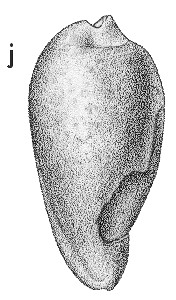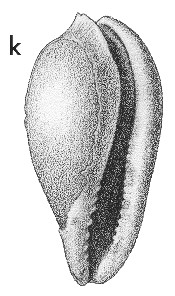
Revised descriptions of New Zealand Cenozoic Mollusca from Beu and Maxwell (1990)

 | Revised descriptions of New Zealand Cenozoic Mollusca from Beu and Maxwell (1990) | 
|
  (Pl. 4j): GS12159, CH/f471, coastal cliffs near The Bluff, Pitt Island, Waipawan (?) (GNS) |
  (Pl. 4k): GS12159, CH/f471, coastal cliffs near The Bluff, Pitt Island, Waipawan (?) (GNS) |
Beu & Maxwell (1990): Chapter 6; p. 96; pl. 4 j, k.
Synonymy: Cypraea (Zoila) n. sp., Beu & Maxwell 1990, p. 96, pl. 4j, k; ?Palaeocypraea eripnides Darragh 2002, p. 357, fig. 2A-D.
Classification: Cypraeidae
Description: Size moderate for family (height 45-53 mm), slender, constricted anteriorly. Protoconch not distinguishable from rest of shell, apical whorls forming a narrowly conical spire fused to and scarcely protruding beyond the posterior prolongation of the inner lip. No sculpture. Aperture narrow, inner and outer lips almost parallel except near anterior end where they diverge somewhat above the narrow siphonal channel. Posterior end of inner lip a sharp, curved ridge fused to spire. Denticles on inner and outer lips rather weak, absent from posterior third or so. Columella with well developed fossula near anterior end, flat or slightly convex above.
Comparison: Cypraeoidea are typically tropical or subtropical in distribution at the present day, and have a very patchy fossil record in New Zealand. At least four species (the oldest recorded from the New Zealand region) occur in the Red Bluff Tuff on Pitt Island, confirming evidence from other fossil groups that the earliest Eocene was one of the warmest periods in the New Zealand Cenozoic. Palaeocypraea(?) eripnides was referred only tentatively to the genus by Darragh (2002, p. 357) because of its elongate shape, resembling that of the Australian Cenozoic-Recent cypraeid genus Umbilia. The original assignment to Zoila (Beu & Maxwell 1990, p. 96) was an error for Umbilia, and this species might still be better referred there, as an early species with a protruding spire. The earliest species definitely referred to Umbilia is late Oligocene (Darragh 2002, p. 360), and this species, U. platyrhynca (McCoy, 1876) (Darragh 2002, p. 359, fig. 2E, F, H-K, 3A-F) resembles P. eripnides quite closely in shape, apart from its short spire. It seems likely that P. eripnides was at least among the early cowries that gave rise to Umbilia. Darragh (2002, p. 357) pointed out that P. eripnides "is one of the oldest cowries known from the Southern Hemisphere", so this and the other taxa occurring syntopically (including Bernaya chathamensis Cernohorsky, 1971, and 2 unnamed species) consitute a very early, surprisingly diverse cowry fauna.
Distribution: Waipawan (?), Red Bluff Tuff, coast northeast of Flowerpot Harbour, Pitt Island, Chathams, associated with warm-water molluscs including Spondylus, Ctenoides and another cypraeid.
Cite this publication as: "A.G. Beu and J.I. Raine (2009). Revised
descriptions of New Zealand Cenozoic Mollusca from Beu and Maxwell (1990). GNS
Science miscellaneous series no. 27."
© GNS Science, 2009
ISBN
978-0-478-19705-1
ISSN 1177-2441
(Included with a PDF facsimile file
copy of New Zealand Geological Survey Paleontological Bulletin 58 in CD version
from: Publications Officer, GNS Science, P.O. Box 30368 Lower Hutt, New
Zealand)